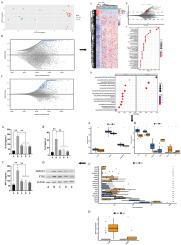清热化浊汤通过免疫检查点和铁下垂调节IgA肾病
IF 3
3区 医学
Q1 INTEGRATIVE & COMPLEMENTARY MEDICINE
Journal of Traditional and Complementary Medicine
Pub Date : 2025-10-01
DOI:10.1016/j.jtcme.2024.11.005
引用次数: 0
摘要
清热化浊汤是一种中药汤剂,已被中医大师在临床上使用了50多年,效果良好。然而,其机制尚不清楚,需要进一步阐明。研究目的结合网络药理学、单细胞测序和实验研究,验证QRHZT通过免疫检查点和铁下垂调控IgA肾病的机制。材料与方法筛选免疫球蛋白A (IgA)肾病(IgAN)患者足细胞单细胞测序数据,从ETCM数据库获取QRHZT靶点信息。使用R语言对KEGG、GSEA、免疫检查点和铁下垂数据进行分析和绘制。最后,实验验证了相关免疫检查点和铁下垂靶点。结果qrhzt可通过免疫检查点FIT、FTH1、AKR1C3、IL6和铁衰相关基因PVR、IFNG调控IgAN。结论qrhzt具有调节IgAN的潜力,组学策略与网络药理学相结合是探索中药作用机制的可行方法。本文章由计算机程序翻译,如有差异,请以英文原文为准。

Qingre huazhuo tang regulates IgA nephropathy through immune checkpoints and ferroptosis
Background
Qingre huazhuo tang (QRHZT) is a traditional Chinese medicine decoction that has been used clinically by traditional Chinese medicine masters for more than 50 years with good results. However, its mechanism is unknown, and further elucidation is necessary.
Aim of the study
To verify the mechanism by which QRHZT regulates IgA nephropathy through immune checkpoints and ferroptosis by combining network pharmacology, single-cell sequencing and experimental studies.
Materials and methods
The single-cell sequencing data obtained from podocytes of immunoglobulin A (IgA) nephropathy (IgAN) patients were screened, and the QRHZT target information was obtained from the ETCM database. Moreover, the KEGG, GSEA, immune checkpoint and ferroptosis data were analyzed and plotted using R language. Finally, the relevant immune checkpoint and ferroptosis targets were validated experimentally.
Results
QRHZT can regulate IgAN through the immune checkpoints FIT, FTH1, AKR1C3, and IL6 and the ferroptosis-related genes PVR and IFNG.
Conclusion
QRHZT has the potential to regulate IgAN, and omics strategies combined with network pharmacology is a feasible method for exploring the mechanisms of traditional Chinese medicines.
求助全文
通过发布文献求助,成功后即可免费获取论文全文。
去求助
来源期刊

Journal of Traditional and Complementary Medicine
Medicine-Complementary and Alternative Medicine
CiteScore
9.30
自引率
6.70%
发文量
78
审稿时长
66 days
期刊介绍:
eJTCM is committed to publish research providing the biological and clinical grounds for using Traditional and Complementary Medical treatments as well as studies that demonstrate the pathophysiological and molecular/biochemical bases supporting the effectiveness of such treatments. Review articles are by invitation only.
eJTCM is receiving an increasing amount of submission, and we need to adopt more stringent criteria to select the articles that can be considered for peer review. Note that eJTCM is striving to increase the quality and medical relevance of the publications.
 求助内容:
求助内容: 应助结果提醒方式:
应助结果提醒方式:


